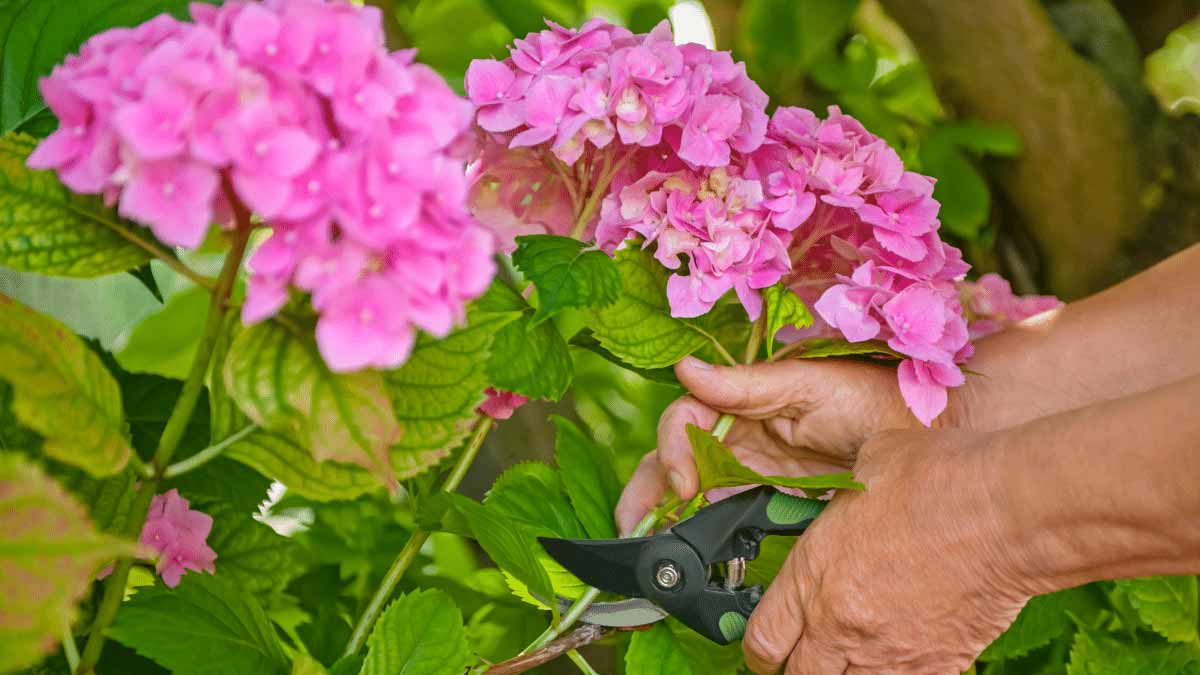Hydrangea pruning sounds fussy, yet it’s mostly timing, touch, and a little patience. Those cloudlike blooms steal the show, even as they fade. You want more of that magic next summer. You also want a plant that stays healthy and calm. Let’s make both happen without turning the garden into homework.
Hydrangea pruning
Start by seeing what’s in front of you. Not every hydrangea plays by the same rules. Bigleaf types flower on last year’s wood. Paniculata and smooth hydrangea bloom on new growth. That one detail shapes everything. Get it right and the shrub rewards you in waves. Get it wrong and you cut off tomorrow’s show. Keep tools clean and sharp.
A quick swipe with alcohol saves a season. Hydrangeas love gentle edits, not brutal makeovers. Think small cuts, steady breath, and clear goals. With that in mind, hydrangea pruning stops feeling scary and starts feeling like care. You’ll read stems, not guess. You’ll keep the shape soft, the energy strong. That’s the whole game with hydrangea pruning—right plant, right moment, right cut.
Know Your Bloomers, Save Your Blooms
Macrophylla and serrata carry their buds through winter. Oakleaf does too. Those are “old wood” bloomers. Touch them lightly after flowering, and pause before deep cuts. Leave the dried heads on through winter in cold zones. They act like little hats, shielding tender buds. Come spring, snip each spent bloom back to the first fat pair of buds. Clean, quick, done.
For paniculata and arborescens, you’ve got more freedom. They set buds on the current season’s stems. Cut harder in late winter to spark fresh, sturdy shoots. Aim for thirty to fifty centimeters from the ground on mature plants. Remove crossing stems so air can move. Less mildew, more flowers. This is where hydrangea pruning earns its halo. You protect next summer’s color while keeping the plant balanced. Light where needed. Bold where allowed. Always with purpose.
When to Cut, and When to Wait
Some gardeners snip the moment petals fade. That polished look can be lovely. It also suits regions with mild winters. Cut back to the second pair of leaves below each head. Compost the trimmings. Wipe the blades again. If frosts bite where you live, hold your nerve. Leave those papery blooms on until March or April.
They’re beautiful under frost, and they guard the new buds. In spring, remove spent heads on old-wood types with a single clean cut. Stop there. Go further and you lose the season. On new-wood bloomers, spring is your window for shape and vigor. Reduce to a neat framework that suits the plant’s strength. Open the center, lift the light, and watch the shrub answer. That’s hydrangea pruning as a rhythm, not a chore. Week by week, the plant tells you what it needs.
Shape, Health, and the Little Details
Pruning isn’t only about flowers. It’s also hygiene and flow. Start by removing dead, damaged, or diseased wood. Take out stems rubbing like crossed swords. Choose a few strong canes to carry the show. Let the rest step back. Cut at a slight angle above a healthy bud. No ragged stubs, no tearing bark. Keep the crown airy so leaves dry fast after rain.
Fewer fungal surprises. Feed the roots with leaf mold and a gentle mulch. Keep soil cool and moist, never soggy. Blue lovers can tweak soil with aluminum-rich amendments, slate chips, or the right ericaceous mix. Pink fans lean less acidic. Whatever the palette, hydrangea pruning sets the stage. The plant focuses energy where it counts. You get full heads, sturdy stems, and a shape that reads serene. A gardener’s version of editing a sentence until it sings.
Cut for the Vase, Dry for Winter, Plan for Joy
Dried heads are a small miracle. Time them right, and they last for months. Harvest near the end of the show, before petals brown completely. Choose a fair, dry day. Snip short, just above two healthy buds. Strip damaged leaves. Hang stems upside down in a dark, airy spot. Color holds longer away from sun. For fresh arrangements, cut early morning and condition in cool water. They’ll drink deep and stay proud on the table.
Back outside, think about placement. Hydrangeas glow on the north side where other plants sulk. Give them humus-rich soil and a gentle breeze. Water deeply in heat, then let the surface dry. Repeat your light spring check-up each year. The habit becomes second nature. You’ll glance at the shrub and know what to do. That’s the quiet confidence hydrangea pruning gives you. More blooms, fewer worries, and a garden that feels generous. The plant thrives. You do too.
